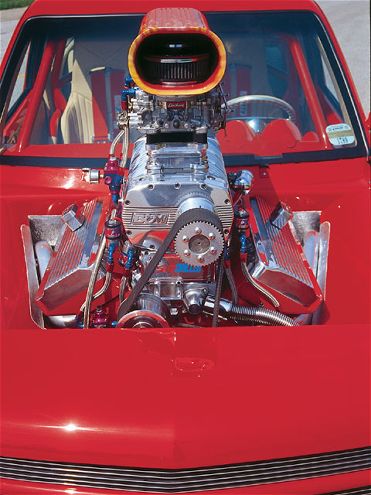
| v8 Engine Conversion Guide engine
If you want to put a V-8 engine in your mini-truck, there are plenty of options to consider. We did the legwork and put together a comprehensive V-8 conversion guide with some things you'll need to know to begin moving in the right direction. The most important step in any engine swap is making a plan. Before you begin the actual swap, make a realistic wish-list of parts on paper. You should consult technical manuals such as the Jags That Run (JTR) V-8 Engine Conversion and the sources from Advanced Adapters.
Once you've ordered and gathered your parts and have a plan of action drawn up, map out a timeline. The average time for an engine swap can vary greatly depending on your schedule, the funds, and numerous other factors. Some experienced shops that perform V-8 conversions day in and day out boast a two to three day install. If you're jumping into this project headfirst and performing the swap yourself, allow plenty of time to work out all the bugs that can arise as the swap progresses.
Another important thing to keep in mind is cost. Most people don't have the funds to build a $10,000 motor and swap it into their mini-truck. Since the junkyard is a mini-trucker's paradise, you may want to start there. Good engines, transmissions, and most parts you'll need for such a big project can easily be found hiding at your local parts graveyard. Most yards offer some kind of warranty on motors and transmissions, but ask before you buy. The final price of the swap can drastically increase depending on the engine, the engine's fuel system (carbureted or fuel-injected), and the transmission. Choosing to have a shop perform the swap can also change the price considerably. The average cost we found for a V-8 conversion, including all the necessary parts, is between $3,500 and $7,500.
Manuals referenced: Jags That Run V-8 Conversions (JTR), Advanced Adapters Installation Manual
Online SourcesParts and Information:www.advanceadapters.com - motor mounts, complete kits, installation guides, technical information
www.flex-a-lite.com - electric fans and accessories
www.godfathercustoms.com - hoods and accessories
www.howell-efi.com - fuel-injected kits and wiring
www.jagsthatrun.com - reference materials, conversion parts, technical information
www.jegs.com - engine parts
www.leeshightechtrucks.com - V-8 swaps, custom wiring harnesses
www.painlessperformance.com - complete wiring solutions
www.pawengineparts.com - engine parts
www.s10v8.com - (small fee applies for membership) question forum, parts
www.summitracing.com - headers, engine parts
www.tdperformance.com - motor mounts, engine parts
www.ultimatecustoms.ca/index2.html - V-8 installation, conversion kits, parts
www.v8conversion.com - FAQ forum, parts, company information
www.v8-ranger.com/swapkits/swapkits - Ford 302ci swap information
www.vintageair.com - compact air-conditioning units, front-runner systems
www.calminitruck.com
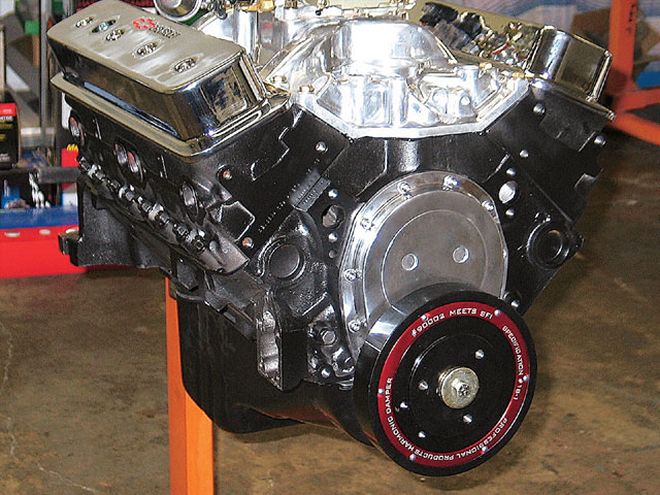
| This is a GM Goodwrench 350ci long-block crate motor that has been built at Joe Sherman Racing.
There are many engines available out there that are ready and willing to be put to the test. The engine you choose will have to be matched to a transmission that will function properly with the new motor. The most common engines used for these conversions are the 350ci Chevy small-block and the 5.7L 320ci Mustang motors. JTR uses the '88-'92 Camaro/Firebird 350 TPI motors for most of its smog-legal engine swaps performed on the same-year trucks. JTR recommends the 700R4 transmission, or if you opt for a manual transmission, the Borg-Warner T-5. These transmissions, along with the 4L60E, work well with the Chevy V-8 conversions, depending on the horsepower and torque the engine puts out. Depending on your budget, the engine and tranny will be the main chunks of dough spent if performing the install yourself. Some other creative engine choices include the Buick V-8s and the Toyota I-Force V-8 engine. If you can afford a brand-new motor, it might be best to have a crate motor built to your specs, such as the one pictured here.
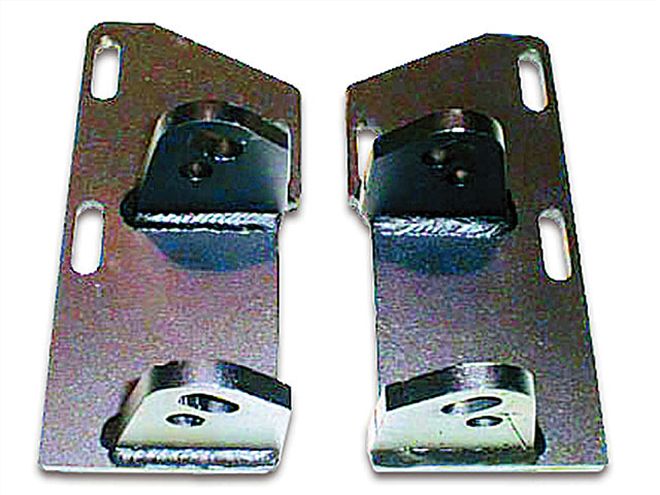
| This is a set of motor mounts offered by Advanced Adapters, which will make your engine-mounting duties straightforward.
There are a number of ways to mount your new motor. Some people choose to use their factory mounts and adapt them to work with the V-8 motor mounts, while others build new mounts. To make this swap easy, various mounting kits are available through a few of the companies in our online source guide. If you're not an experienced fabricator, we recommended you use one of these engine-mounting options. You can find Stealth Conversion motor mounts at JTR. A few other companies offer custom motor mounts, such as Advanced Adapters and Ultimate Customs. If you decide to build your own, you're going to have to test-fit the engine several times before getting the mounts and engine properly lined up. Measure and mark your locations before you completely weld in the motor mounts. The motor mounts are a crucial step and will need to withstand the brutal task of holding the engine in place under stress.
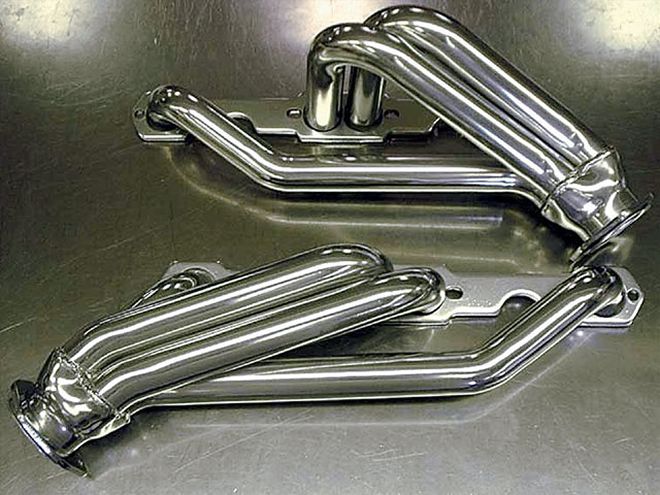
| v8 Engine Conversion Guide headers
The exhaust system will most likely consist of conversion-specific headers. You can find conversion headers at Summit Racing and many of the other companies listed in the source guide. Depending on your headers or exhaust manifolds, the steering might have to be moved over, or run through the header. The exhaust will have to be redone as well. The exhaust system will vary greatly, depending on what model and year the truck and engine are, and what state you live in for applicable smog laws.
The choice of header is going to make a difference on clearance, especially when it comes to the steering, the firewall, the oil pan, and the frame. Choose wisely for your particular application.
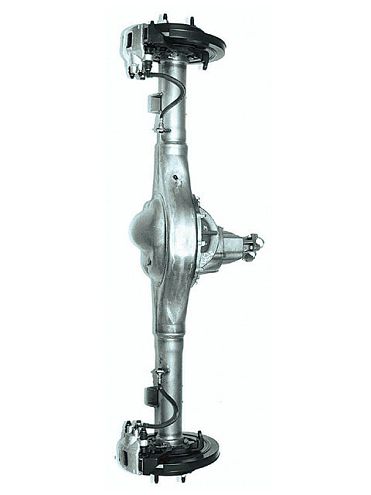
| v8 Engine Conversion Guide driveshaft
On some trucks (generation I and II S-10/S-15), the stock driveshaft will slide into the new automatic or manual transmission. The TH400/350, 700R4, and 4L60E transmissions all use the same spline for the transmission yoke. Depending on where the new motor is mounted, you will need to have the driveshaft lengthened or shortened, corresponding to the amount you move the engine forward or rearward. We always recommend that you have a heavy-duty driveshaft built to keep it from twisting. If you place the engine in the exact same spot as the original engine mounts, the driveshaft will be the same length. The stock rearend might be all right for your conversion, depending on the engine and transmission used and the size of the stock rearend. If you're going high performance, or your truck's stock differential is smaller than 8 inches, definitely look into using a larger differential. For the rearend, we recommend doing the same as with the driveshaft: Beef it up now while the swap is in progress (Ford 9-inch rearends seem to be the differentials and housings of choice).
We recommend using a stronger rearend and driveshaft to withstand the new performance output of your engine and transmission.
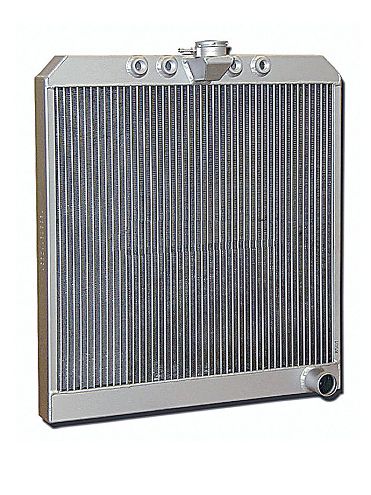
| v8 Engine Conversion Guide radiator
Most of the V-8 swaps performed aren't going to use the stock radiator; you'll need to upgrade to a radiator that has more cooling capacity. For example, the Corvette aluminum radiator that JTR offers is a very popular radiator for the S-10 350ci swaps. Your core support may need some modifications to make the new radiator fit. You'll also want to move the radiator as close to the front of the truck as possible without interfering with the grille and headlights. There are two options for cooling fans. If you have enough room for an engine-driven fan, you might want to consider using one. Otherwise, install at least one low-profile electric fan; if you can fit them, two are highly recommended. The area between the radiator and fan is where the engine seems to fit the tightest, so most people prefer to move their engine rearward. The running temperature of the engine is one of the major concerns of performing an engine swap, so this step is crucial.
A critical component of the engine swap is the proper-size radiator and cooling fans to keep your mini running without overheating.
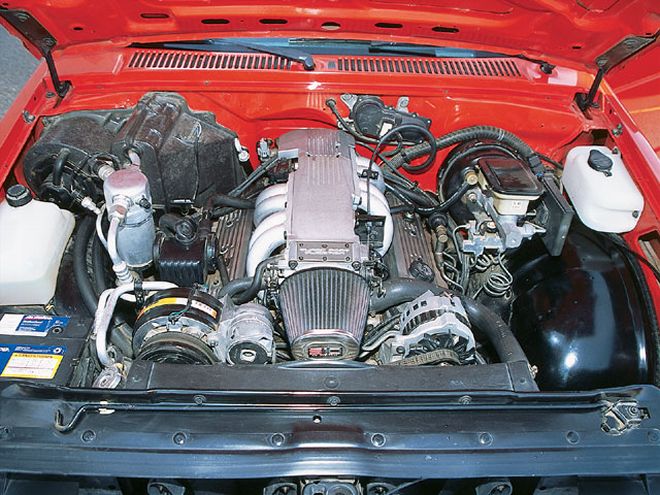
| This is a first-generation S-10 with a smog-legal, tuned port fuel-injected 350ci engine swap.
The question about which fuel system you'll run depends primarily on your smog concerns and the applicable laws in your state. If you're planning on having a smog-legal truck after the swap, keep all the specified smog equipment that originally came with your donor motor (also available from the junkyard). The engine will also be fuel-injected, which in turn means you'll need a computer to manage the fuel system and other engine essentials. You can contact Howell Engine Developments, where you'll find the necessary components for fuel injection and wiring applications for most V-8 engines. If you're fortunate enough to live in a state where these laws don't apply, then carburetion is probably easier and less expensive, and can easily be tuned for high-performance applications.
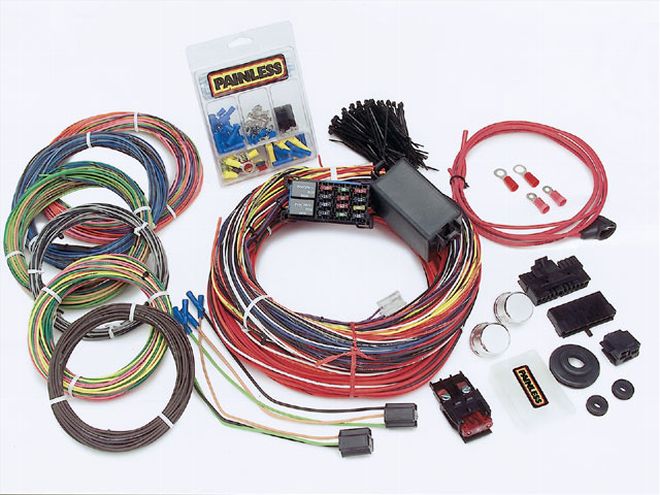
| v8 Engine Conversion Guide wiring Harness
For the electrical wiring of the new engine, you can attempt to piece together a wiring harness to work with the V-8 motor, or go with an aftermarket one. Depending on whether your engine for the swap is carbureted or fuel-injected, you may or may not need an engine management computer. It's easier and much cleaner to purchase a new harness from Painless Performance Wiring or Lee's High Tech Trucks. Both of these companies offer complete conversion harnesses as well as wiring tips and instructions. Having a complete harness made is especially nice since you can have your harness built to length.
Rewiring your truck with the new motor is made much cleaner with a complete wiring harness and instructions.
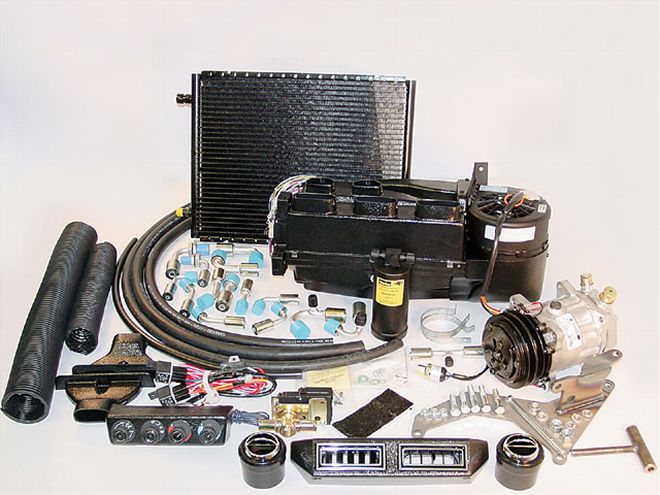
| Comforts such as air conditioning might still be possible after the engine swap, even if your truck is body-dropped. Vintage Air makes ultra-compact A/C units that work well with body-dropped trucks.
If you have air conditioning or power steering (especially on S-10s) and the truck isn't body-dropped, you might be able to keep your A/C and power steering by building or finding brackets that move the compressor and pump out of the way. A custom belt will have to be purchased in order to turn the compressor and pump. If your truck is body-dropped, or you have enormous rims (or both), check out Vintage Air's compact air-conditioning units. If your truck is or will be body-dropped, hood clearance could be another potential problem. With the bigger motor, consider using a cowl-induction hood for clearance. We recommend checking out some of the hoods Godfather Customs offers.
With this introduction to V-8 conversions complete, our next step will be the buildup of a 350ci crate motor. Check back next month to witness its construction in Volume II of our V-8 series. (Don't worry - in Volume III we'll actually swap the engine into an S-10.)
 | v8 Engine Conversion Guide engine
If you want to put a V-8 engine in your mini-truck, there are plenty of options to consider. We did the legwork and put together a comprehensive V-8 conversion guide with some things you'll need to know to begin moving in the right direction. The most important step in any engine swap is making a plan. Before you begin the actual swap, make a realistic wish-list of parts on paper. You should consult technical manuals such as the Jags That Run (JTR) V-8 Engine Conversion and the sources from Advanced Adapters.
Once you've ordered and gathered your parts and have a plan of action drawn up, map out a timeline. The average time for an engine swap can vary greatly depending on your schedule, the funds, and numerous other factors. Some experienced shops that perform V-8 conversions day in and day out boast a two to three day install. If you're jumping into this project headfirst and performing the swap yourself, allow plenty of time to work out all the bugs that can arise as the swap progresses.
Another important thing to keep in mind is cost. Most people don't have the funds to build a $10,000 motor and swap it into their mini-truck. Since the junkyard is a mini-trucker's paradise, you may want to start there. Good engines, transmissions, and most parts you'll need for such a big project can easily be found hiding at your local parts graveyard. Most yards offer some kind of warranty on motors and transmissions, but ask before you buy. The final price of the swap can drastically increase depending on the engine, the engine's fuel system (carbureted or fuel-injected), and the transmission. Choosing to have a shop perform the swap can also change the price considerably. The average cost we found for a V-8 conversion, including all the necessary parts, is between $3,500 and $7,500.
Manuals referenced: Jags That Run V-8 Conversions (JTR), Advanced Adapters Installation Manual
Online Sources
| v8 Engine Conversion Guide engine
If you want to put a V-8 engine in your mini-truck, there are plenty of options to consider. We did the legwork and put together a comprehensive V-8 conversion guide with some things you'll need to know to begin moving in the right direction. The most important step in any engine swap is making a plan. Before you begin the actual swap, make a realistic wish-list of parts on paper. You should consult technical manuals such as the Jags That Run (JTR) V-8 Engine Conversion and the sources from Advanced Adapters.
Once you've ordered and gathered your parts and have a plan of action drawn up, map out a timeline. The average time for an engine swap can vary greatly depending on your schedule, the funds, and numerous other factors. Some experienced shops that perform V-8 conversions day in and day out boast a two to three day install. If you're jumping into this project headfirst and performing the swap yourself, allow plenty of time to work out all the bugs that can arise as the swap progresses.
Another important thing to keep in mind is cost. Most people don't have the funds to build a $10,000 motor and swap it into their mini-truck. Since the junkyard is a mini-trucker's paradise, you may want to start there. Good engines, transmissions, and most parts you'll need for such a big project can easily be found hiding at your local parts graveyard. Most yards offer some kind of warranty on motors and transmissions, but ask before you buy. The final price of the swap can drastically increase depending on the engine, the engine's fuel system (carbureted or fuel-injected), and the transmission. Choosing to have a shop perform the swap can also change the price considerably. The average cost we found for a V-8 conversion, including all the necessary parts, is between $3,500 and $7,500.
Manuals referenced: Jags That Run V-8 Conversions (JTR), Advanced Adapters Installation Manual
Online Sources | This is a GM Goodwrench 350ci long-block crate motor that has been built at Joe Sherman Racing.
There are many engines available out there that are ready and willing to be put to the test. The engine you choose will have to be matched to a transmission that will function properly with the new motor. The most common engines used for these conversions are the 350ci Chevy small-block and the 5.7L 320ci Mustang motors. JTR uses the '88-'92 Camaro/Firebird 350 TPI motors for most of its smog-legal engine swaps performed on the same-year trucks. JTR recommends the 700R4 transmission, or if you opt for a manual transmission, the Borg-Warner T-5. These transmissions, along with the 4L60E, work well with the Chevy V-8 conversions, depending on the horsepower and torque the engine puts out. Depending on your budget, the engine and tranny will be the main chunks of dough spent if performing the install yourself. Some other creative engine choices include the Buick V-8s and the Toyota I-Force V-8 engine. If you can afford a brand-new motor, it might be best to have a crate motor built to your specs, such as the one pictured here.
| This is a GM Goodwrench 350ci long-block crate motor that has been built at Joe Sherman Racing.
There are many engines available out there that are ready and willing to be put to the test. The engine you choose will have to be matched to a transmission that will function properly with the new motor. The most common engines used for these conversions are the 350ci Chevy small-block and the 5.7L 320ci Mustang motors. JTR uses the '88-'92 Camaro/Firebird 350 TPI motors for most of its smog-legal engine swaps performed on the same-year trucks. JTR recommends the 700R4 transmission, or if you opt for a manual transmission, the Borg-Warner T-5. These transmissions, along with the 4L60E, work well with the Chevy V-8 conversions, depending on the horsepower and torque the engine puts out. Depending on your budget, the engine and tranny will be the main chunks of dough spent if performing the install yourself. Some other creative engine choices include the Buick V-8s and the Toyota I-Force V-8 engine. If you can afford a brand-new motor, it might be best to have a crate motor built to your specs, such as the one pictured here.
 | This is a set of motor mounts offered by Advanced Adapters, which will make your engine-mounting duties straightforward.
There are a number of ways to mount your new motor. Some people choose to use their factory mounts and adapt them to work with the V-8 motor mounts, while others build new mounts. To make this swap easy, various mounting kits are available through a few of the companies in our online source guide. If you're not an experienced fabricator, we recommended you use one of these engine-mounting options. You can find Stealth Conversion motor mounts at JTR. A few other companies offer custom motor mounts, such as Advanced Adapters and Ultimate Customs. If you decide to build your own, you're going to have to test-fit the engine several times before getting the mounts and engine properly lined up. Measure and mark your locations before you completely weld in the motor mounts. The motor mounts are a crucial step and will need to withstand the brutal task of holding the engine in place under stress.
| This is a set of motor mounts offered by Advanced Adapters, which will make your engine-mounting duties straightforward.
There are a number of ways to mount your new motor. Some people choose to use their factory mounts and adapt them to work with the V-8 motor mounts, while others build new mounts. To make this swap easy, various mounting kits are available through a few of the companies in our online source guide. If you're not an experienced fabricator, we recommended you use one of these engine-mounting options. You can find Stealth Conversion motor mounts at JTR. A few other companies offer custom motor mounts, such as Advanced Adapters and Ultimate Customs. If you decide to build your own, you're going to have to test-fit the engine several times before getting the mounts and engine properly lined up. Measure and mark your locations before you completely weld in the motor mounts. The motor mounts are a crucial step and will need to withstand the brutal task of holding the engine in place under stress.
 | v8 Engine Conversion Guide headers
The exhaust system will most likely consist of conversion-specific headers. You can find conversion headers at Summit Racing and many of the other companies listed in the source guide. Depending on your headers or exhaust manifolds, the steering might have to be moved over, or run through the header. The exhaust will have to be redone as well. The exhaust system will vary greatly, depending on what model and year the truck and engine are, and what state you live in for applicable smog laws.
The choice of header is going to make a difference on clearance, especially when it comes to the steering, the firewall, the oil pan, and the frame. Choose wisely for your particular application.
| v8 Engine Conversion Guide headers
The exhaust system will most likely consist of conversion-specific headers. You can find conversion headers at Summit Racing and many of the other companies listed in the source guide. Depending on your headers or exhaust manifolds, the steering might have to be moved over, or run through the header. The exhaust will have to be redone as well. The exhaust system will vary greatly, depending on what model and year the truck and engine are, and what state you live in for applicable smog laws.
The choice of header is going to make a difference on clearance, especially when it comes to the steering, the firewall, the oil pan, and the frame. Choose wisely for your particular application.
 | v8 Engine Conversion Guide driveshaft
On some trucks (generation I and II S-10/S-15), the stock driveshaft will slide into the new automatic or manual transmission. The TH400/350, 700R4, and 4L60E transmissions all use the same spline for the transmission yoke. Depending on where the new motor is mounted, you will need to have the driveshaft lengthened or shortened, corresponding to the amount you move the engine forward or rearward. We always recommend that you have a heavy-duty driveshaft built to keep it from twisting. If you place the engine in the exact same spot as the original engine mounts, the driveshaft will be the same length. The stock rearend might be all right for your conversion, depending on the engine and transmission used and the size of the stock rearend. If you're going high performance, or your truck's stock differential is smaller than 8 inches, definitely look into using a larger differential. For the rearend, we recommend doing the same as with the driveshaft: Beef it up now while the swap is in progress (Ford 9-inch rearends seem to be the differentials and housings of choice).
We recommend using a stronger rearend and driveshaft to withstand the new performance output of your engine and transmission.
| v8 Engine Conversion Guide driveshaft
On some trucks (generation I and II S-10/S-15), the stock driveshaft will slide into the new automatic or manual transmission. The TH400/350, 700R4, and 4L60E transmissions all use the same spline for the transmission yoke. Depending on where the new motor is mounted, you will need to have the driveshaft lengthened or shortened, corresponding to the amount you move the engine forward or rearward. We always recommend that you have a heavy-duty driveshaft built to keep it from twisting. If you place the engine in the exact same spot as the original engine mounts, the driveshaft will be the same length. The stock rearend might be all right for your conversion, depending on the engine and transmission used and the size of the stock rearend. If you're going high performance, or your truck's stock differential is smaller than 8 inches, definitely look into using a larger differential. For the rearend, we recommend doing the same as with the driveshaft: Beef it up now while the swap is in progress (Ford 9-inch rearends seem to be the differentials and housings of choice).
We recommend using a stronger rearend and driveshaft to withstand the new performance output of your engine and transmission.
 | v8 Engine Conversion Guide radiator
Most of the V-8 swaps performed aren't going to use the stock radiator; you'll need to upgrade to a radiator that has more cooling capacity. For example, the Corvette aluminum radiator that JTR offers is a very popular radiator for the S-10 350ci swaps. Your core support may need some modifications to make the new radiator fit. You'll also want to move the radiator as close to the front of the truck as possible without interfering with the grille and headlights. There are two options for cooling fans. If you have enough room for an engine-driven fan, you might want to consider using one. Otherwise, install at least one low-profile electric fan; if you can fit them, two are highly recommended. The area between the radiator and fan is where the engine seems to fit the tightest, so most people prefer to move their engine rearward. The running temperature of the engine is one of the major concerns of performing an engine swap, so this step is crucial.
A critical component of the engine swap is the proper-size radiator and cooling fans to keep your mini running without overheating.
| v8 Engine Conversion Guide radiator
Most of the V-8 swaps performed aren't going to use the stock radiator; you'll need to upgrade to a radiator that has more cooling capacity. For example, the Corvette aluminum radiator that JTR offers is a very popular radiator for the S-10 350ci swaps. Your core support may need some modifications to make the new radiator fit. You'll also want to move the radiator as close to the front of the truck as possible without interfering with the grille and headlights. There are two options for cooling fans. If you have enough room for an engine-driven fan, you might want to consider using one. Otherwise, install at least one low-profile electric fan; if you can fit them, two are highly recommended. The area between the radiator and fan is where the engine seems to fit the tightest, so most people prefer to move their engine rearward. The running temperature of the engine is one of the major concerns of performing an engine swap, so this step is crucial.
A critical component of the engine swap is the proper-size radiator and cooling fans to keep your mini running without overheating.
 | This is a first-generation S-10 with a smog-legal, tuned port fuel-injected 350ci engine swap.
The question about which fuel system you'll run depends primarily on your smog concerns and the applicable laws in your state. If you're planning on having a smog-legal truck after the swap, keep all the specified smog equipment that originally came with your donor motor (also available from the junkyard). The engine will also be fuel-injected, which in turn means you'll need a computer to manage the fuel system and other engine essentials. You can contact Howell Engine Developments, where you'll find the necessary components for fuel injection and wiring applications for most V-8 engines. If you're fortunate enough to live in a state where these laws don't apply, then carburetion is probably easier and less expensive, and can easily be tuned for high-performance applications.
| This is a first-generation S-10 with a smog-legal, tuned port fuel-injected 350ci engine swap.
The question about which fuel system you'll run depends primarily on your smog concerns and the applicable laws in your state. If you're planning on having a smog-legal truck after the swap, keep all the specified smog equipment that originally came with your donor motor (also available from the junkyard). The engine will also be fuel-injected, which in turn means you'll need a computer to manage the fuel system and other engine essentials. You can contact Howell Engine Developments, where you'll find the necessary components for fuel injection and wiring applications for most V-8 engines. If you're fortunate enough to live in a state where these laws don't apply, then carburetion is probably easier and less expensive, and can easily be tuned for high-performance applications.
 | v8 Engine Conversion Guide wiring Harness
For the electrical wiring of the new engine, you can attempt to piece together a wiring harness to work with the V-8 motor, or go with an aftermarket one. Depending on whether your engine for the swap is carbureted or fuel-injected, you may or may not need an engine management computer. It's easier and much cleaner to purchase a new harness from Painless Performance Wiring or Lee's High Tech Trucks. Both of these companies offer complete conversion harnesses as well as wiring tips and instructions. Having a complete harness made is especially nice since you can have your harness built to length.
Rewiring your truck with the new motor is made much cleaner with a complete wiring harness and instructions.
| v8 Engine Conversion Guide wiring Harness
For the electrical wiring of the new engine, you can attempt to piece together a wiring harness to work with the V-8 motor, or go with an aftermarket one. Depending on whether your engine for the swap is carbureted or fuel-injected, you may or may not need an engine management computer. It's easier and much cleaner to purchase a new harness from Painless Performance Wiring or Lee's High Tech Trucks. Both of these companies offer complete conversion harnesses as well as wiring tips and instructions. Having a complete harness made is especially nice since you can have your harness built to length.
Rewiring your truck with the new motor is made much cleaner with a complete wiring harness and instructions.
 | Comforts such as air conditioning might still be possible after the engine swap, even if your truck is body-dropped. Vintage Air makes ultra-compact A/C units that work well with body-dropped trucks.
If you have air conditioning or power steering (especially on S-10s) and the truck isn't body-dropped, you might be able to keep your A/C and power steering by building or finding brackets that move the compressor and pump out of the way. A custom belt will have to be purchased in order to turn the compressor and pump. If your truck is body-dropped, or you have enormous rims (or both), check out Vintage Air's compact air-conditioning units. If your truck is or will be body-dropped, hood clearance could be another potential problem. With the bigger motor, consider using a cowl-induction hood for clearance. We recommend checking out some of the hoods Godfather Customs offers.
With this introduction to V-8 conversions complete, our next step will be the buildup of a 350ci crate motor. Check back next month to witness its construction in Volume II of our V-8 series. (Don't worry - in Volume III we'll actually swap the engine into an S-10.)
| Comforts such as air conditioning might still be possible after the engine swap, even if your truck is body-dropped. Vintage Air makes ultra-compact A/C units that work well with body-dropped trucks.
If you have air conditioning or power steering (especially on S-10s) and the truck isn't body-dropped, you might be able to keep your A/C and power steering by building or finding brackets that move the compressor and pump out of the way. A custom belt will have to be purchased in order to turn the compressor and pump. If your truck is body-dropped, or you have enormous rims (or both), check out Vintage Air's compact air-conditioning units. If your truck is or will be body-dropped, hood clearance could be another potential problem. With the bigger motor, consider using a cowl-induction hood for clearance. We recommend checking out some of the hoods Godfather Customs offers.
With this introduction to V-8 conversions complete, our next step will be the buildup of a 350ci crate motor. Check back next month to witness its construction in Volume II of our V-8 series. (Don't worry - in Volume III we'll actually swap the engine into an S-10.)